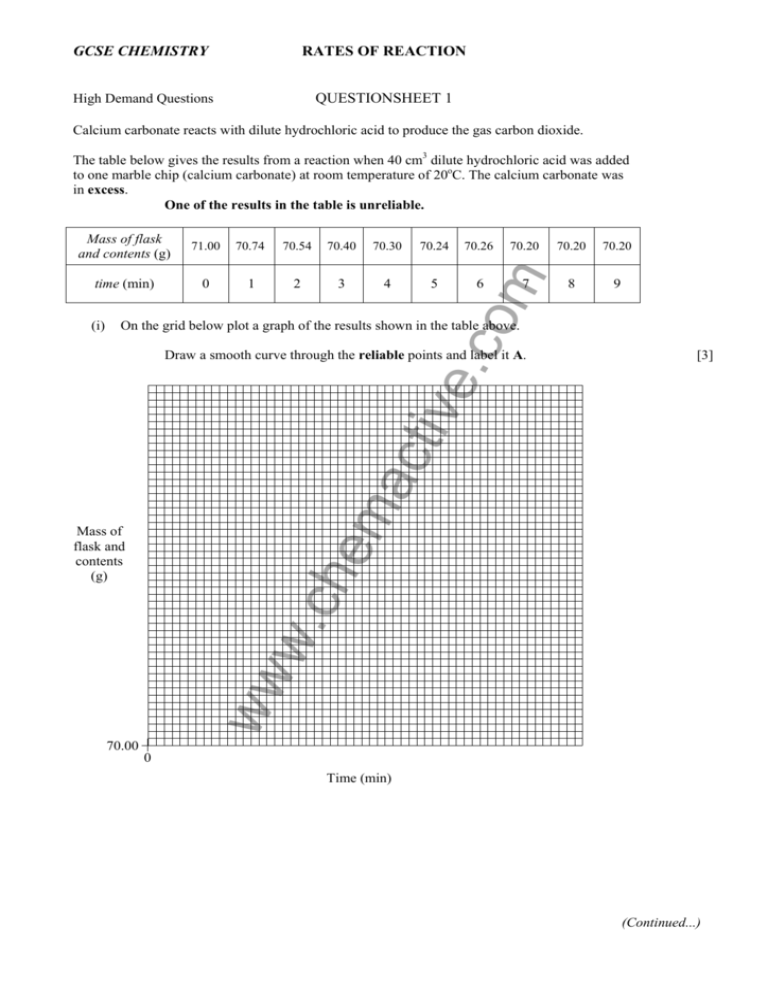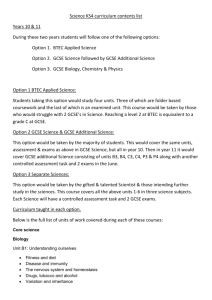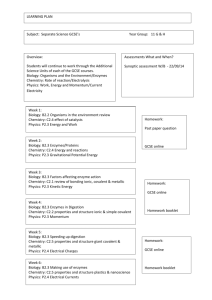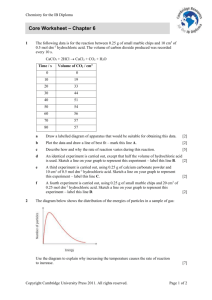GCSE Chemistry: Rates of Reaction Worksheet
advertisement

GCSE CHEMISTRY RATES OF REACTION High Demand Questions QUESTIONSHEET 1 Calcium carbonate reacts with dilute hydrochloric acid to produce the gas carbon dioxide. The table below gives the results from a reaction when 40 cm3 dilute hydrochloric acid was added to one marble chip (calcium carbonate) at room temperature of 20oC. The calcium carbonate was in excess. One of the results in the table is unreliable. 71.00 70.74 70.54 70.40 70.30 70.24 time (min) 0 1 2 3 4 5 70.20 6 7 70.20 70.20 8 9 On the grid below plot a graph of the results shown in the table above. e.c (i) 70.26 om Mass of flask and contents (g) [3] ma ctiv Draw a smooth curve through the reliable points and label it A. ww w.c he Mass of flask and contents (g) 70.00 0 Time (min) (Continued...) GCSE CHEMISTRY RATES OF REACTIONS QUESTIONSHEET 1 CONTINUED (ii) Sketch carefully on the grid the graph that would be obtained if: I. the same reaction was carried out at a temperature of 50oC. Label this graph B. II. when an identical piece of calcium carbonate was reacted with only 20 cm3 of the dilute acid. Label this graph C. [2] [2] (iii) Explain your answer to part (ii) I, in terms of particle collision. om .............................................................................................................................................................................. .............................................................................................................................................................................. ww w.c he ma ctiv e.c ......................................................................................................................................................................... [3] TOTAL / 10 GCSE CHEMISTRY RATES OF REACTION High Demand Questions QUESTIONSHEET 2 Some chemical reactions may take place twice as quickly if their temperature is raised by 10oC. (a) If a particular reaction takes 32 minutes at 20oC, how long will it take if the temperature is raised to 50oC? .............................................................................................................................................................................. .............................................................................................................................................................................. .............................................................................................................................................................................. Plot a graph of temperature against time taken to complete the reaction. [3] (c) ctiv ma ww w.c he Temperature/ oC e.c (b) om ......................................................................................................................................................................... [2] Time / min Explain why the line on your graph does not meet either axis. .............................................................................................................................................................................. .............................................................................................................................................................................. ......................................................................................................................................................................... [2] TOTAL / 7 GCSE CHEMISTRY RATES OF REACTIONS High Demand Questions QUESTIONSHEET 3 Carbonates react with acids to produce a salt, carbon dioxide and water. (a) The equation describes the reaction between calcium carbonate and hydrochloric acid. CaCO3 (i) + 2HCl Æ CaCl2 + CO2 + H2O Add state symbols to complete the equation. [1] om (ii) Name the salt produced in this reaction. ......................................................................................................................................................................... [1] e.c (iii) Use the relative atomic masses C =12, Ca = 40 and O=16 to calculate the relative formula mass of calcium carbonate. Show your working. .............................................................................................................................................................................. (iv) ctiv ......................................................................................................................................................................... [1] How much carbon dioxide can be produced from: A 100 g calcium carbonate? ma .............................................................................................................................................................................. ......................................................................................................................................................................... [2] B 1 g calcium carbonate? he .............................................................................................................................................................................. ......................................................................................................................................................................... [1] A student wished to measure the production of carbon dioxide in the above reaction. She considered the two methods outlined in the diagram. ww w.c (b) Method A add 25 cm3 hydrochloric acid weigh immediately leave for 2 minutes Method B boiling tube with 25 cm3 hydrochloric acid 1g calcium carbonate weigh pour acid into beaker, replace boiling tube in beaker reweigh leave for 2 minutes reweigh (Continued...) GCSE CHEMISTRY RATES OF REACTION QUESTIONSHEET 3 CONTINUED (i) Before carrying out the experiment, she performed the calculation in part (a) (iv) B of this question. Suggest how this information could be of use to her. .............................................................................................................................................................................. .............................................................................................................................................................................. .............................................................................................................................................................................. om ......................................................................................................................................................................... [2] (ii) Explain why, of the two methods shown, method B would provide a more reliable estimate of the amount of carbon dioxide produced during the reaction. e.c .............................................................................................................................................................................. .............................................................................................................................................................................. ctiv .............................................................................................................................................................................. ww w.c he ma ......................................................................................................................................................................... [2] TOTAL / 10 GCSE CHEMISTRY RATES OF REACTIONS High Demand Questions QUESTIONSHEET 4 Raj’s chemistry teacher puts a beaker of sodium thiosulphate on the windowsill. Raj can clearly see a tree on the school field through the beaker. The teacher adds hydrochloric acid to the beaker. After 120 seconds Raj cannot see the tree although he is looking carefully. (a) Explain why. .............................................................................................................................................................................. ......................................................................................................................................................................... [2] om The teacher repeats the experiment with three other classes. The tree disappears from view at different times. Time for tree to disappear in seconds 120 200 150 Class ctiv e.c 9X 9Y 9Z The three experiments were identical except for the day on which they were done. (i) Which class did the experiment: on a warm spring day? ma (b) ......................................................................................................................................................................... [1] he (ii) during a summer heat wave? ......................................................................................................................................................................... [1] ww w.c (iii) on a January day when the school heating was not working well? ......................................................................................................................................................................... [1] The following year the local group of schools agree to do the same experiment on the same day under exactly the same conditions using the same chemicals. They look at objects that are the same distance away. The results are: - School St Peter’s St Paul’s St Mary’s Time for tree to disappear in seconds 110 100 150 The teachers tested the chemicals used. They found that the sodium thiosulphate was of different concentration in each school. (c)(i) Which school had the strongest solution? ......................................................................................................................................................................... [1] (Continued...) GCSE CHEMISTRY RATES OF REACTION QUESTIONSHEET 4 CONTINUED (ii) Give reasons for your answer. .............................................................................................................................................................................. ......................................................................................................................................................................... [2] Hanif decides to use an ultraviolet lamp and an electric motor powered by a photoelectric cell. om How could he use this equipment to measure the cloudiness of the liquid in a more objective way? Draw a diagram of how the equipment might be set up. .............................................................................................................................................................................. e.c .............................................................................................................................................................................. .............................................................................................................................................................................. he ma ctiv .............................................................................................................................................................................. ww w.c (d) [4] TOTAL / 12 GCSE CHEMISTRY RATES OF REACTIONS High Demand Questions QUESTIONSHEET 5 Cotton is starched to make it easier to weave into denim cloth. Before the cloth is made up into clothing the starch is removed so that it can be more easily sewn. Denim from a newly woven roll is tested to find out the best conditions for the removal of starch using the biological catalyst amylase. A solution of amylase is made up and five equal pieces are cut from the roll of denim. Equal quantities of amylase are added to four of the five pieces in separate beakers. The beakers are kept at temperatures of 20oC, 40oC, 60oC and 80oC respectively for 15 minutes. Afterwards all five pieces are tested for starch. What is a catalyst? om (a) (i) ......................................................................................................................................................................... [2] e.c (ii) What is the name given to biological catalysts? ......................................................................................................................................................................... [1] Which of the cotton samples would you expect to contain the most starch? ctiv (b) (i) ......................................................................................................................................................................... [1] (ii) Explain your answer. ma .............................................................................................................................................................................. .............................................................................................................................................................................. he ......................................................................................................................................................................... [3] (iii) Which sample would you expect to contain the least starch? ww w.c ......................................................................................................................................................................... [1] (iv) Explain your answer. .............................................................................................................................................................................. ......................................................................................................................................................................... [2] (v) What chemical is most often used to detect starch? ......................................................................................................................................................................... [1] TOTAL / 11 GCSE CHEMISTRY RATES OF REACTION High Demand Questions QUESTIONSHEET 6 The following equation shows what happens when magnesium ribbon reacts with hydrochloric acid. Mg(s) + 2HCl(aq) Æ MgCl2(aq) + H2(g) (a) What would you see happening to the magnesium ? ......................................................................................................................................................................... [1] 40 cm3 of gas is collected in 10 seconds. What is the rate of reaction? om (b) ......................................................................................................................................................................... [1] How would the rate compare if you used very dilute hydrochloric acid? Explain why. e.c (c) .............................................................................................................................................................................. (d) ctiv ......................................................................................................................................................................... [2] State two ways in which the reaction could be speeded up besides changing the concentration of hydrochloric acid. ma .............................................................................................................................................................................. ......................................................................................................................................................................... [2] Calculate how many moles of hydrogen gas are collected. he .............................................................................................................................................................................. .............................................................................................................................................................................. ww w.c (e) ......................................................................................................................................................................... [2] [24 dm3 is the volume of 1 mole of gas at room temperature] TOTAL / 8 GCSE CHEMISTRY RATES OF REACTIONS High Demand Questions QUESTIONSHEET 7 When 0.15 M sodium thiosulphate solution (Na2S2O3(aq)) is added to hydrochloric acid, sulphur is formed. (a) What would you observe during the reaction? ......................................................................................................................................................................... [1] (b) What other products are formed? .............................................................................................................................................................................. om ......................................................................................................................................................................... [2] (c) Apart from heating it, how else could you speed up the reaction? How would this work? e.c .............................................................................................................................................................................. ......................................................................................................................................................................... [2] 30 20 5 27 20 30 5 56 10 40 5 3 min [3] he Plot a graph of the results 40 10 5 13 ww w.c (d) (i) 50 0 5 5 ma Na2S2O3(aq) Volume H2O(l) (cm3) HCl(aq) Reaction Time (s) ctiv The following results table was obtained by mixing various amounts of sodium thiosulphate solution, water and 1 M hydrochloric acid. (Continued...) GCSE CHEMISTRY RATES OF REACTION QUESTIONSHEET 7 CONTINUED (ii) Which variable are you testing? ......................................................................................................................................................................... [1] (iii) Why is the volume of acid kept the same? ......................................................................................................................................................................... [1] (iv) What would you observe during the reaction? ww w.c he ma ctiv e.c om ......................................................................................................................................................................... [1] TOTAL / 11 GCSE CHEMISTRY RATES OF REACTIONS High Demand Questions QUESTIONSHEET 8 Yoghurt is made from milk. Yoghurt contains lactic acid formed from lactose, the sugar present in milk. Recently a new type of yoghurt has appeared in the shops in which bacteria from Russian cosmonauts has been used in the process. (a) Describe a test to show that an acid is formed when milk is turned into yoghurt. State the result of the test. .............................................................................................................................................................................. (b) om ......................................................................................................................................................................... [2] For all practical purposes, a solution of lactose does not change into lactic acid. Adding bacteria increases the rate of reaction. What is meant by the phrase ‘rate of reaction’? e.c .............................................................................................................................................................................. ......................................................................................................................................................................... [2] Why does the addition of bacteria have this effect? ctiv (c) ......................................................................................................................................................................... [1] Describe or draw diagrams to show what is happening to individual molecules of lactose in the reaction to form lactic acid molecules in yoghurt. ma (d) .............................................................................................................................................................................. (e) ww w.c he .............................................................................................................................................................................. [3] After a while the rate of formation of lactic acid decreases. Why is this? ......................................................................................................................................................................... [1] (f) The yoghurt – milk mixture is heated to about 70oC.What effect does this have on the rate of the production of lactic acid? Explain your answer. .............................................................................................................................................................................. ......................................................................................................................................................................... [2] TOTAL / 11 GCSE CHEMISTRY RATES OF REACTION QUESTIONSHEET 9 Medium Demand Questions 2 10 4 16 6 20 8 - [3] he ma ctiv Plot a graph of the results. 10 22 ww w.c (a) 0 0 e.c Time (s) Volume (cm3) om The apparatus shown can be used to collect gas formed by reacting magnesium and sulphuric acid. The following table of data was collected. (Continued...) GCSE CHEMISTRY RATES OF REACTIONS QUESTIONSHEET 9 CONTINUED (b) One experimental result was missed. (i) What value could it have? ......................................................................................................................................................................... [1] (ii) Why is it easy to miss results like this during experiments? (c) (i) om ......................................................................................................................................................................... [1] Which gas is formed in the reaction ? ......................................................................................................................................................................... [1] e.c (ii) How could you test for this gas? ww w.c he ma ctiv ......................................................................................................................................................................... [2] TOTAL / 8 GCSE CHEMISTRY Medium Demand Questions RATES OF REACTION QUESTIONSHEET 10 Some cars are fitted with catalytic converters to remove harmful substances from exhaust gases. om The platinum catalyst is coated onto a honeycombed ceramic support. It works best when the engine has warmed up. (a)(i) Explain why a honeycombed support is better than a solid one. e.c ......................................................................................................................................................................... [1] (ii) Explain why the catalyst works better when the engine is warm. ctiv .............................................................................................................................................................................. ......................................................................................................................................................................... [2] Heavy metals may stick to the catalyst and prevent it from working. The catalyst is said to be poisoned. (i) ma (b) Explain how catalysts work and how poisoning with heavy metals prevents this. he .............................................................................................................................................................................. .............................................................................................................................................................................. ww w.c ......................................................................................................................................................................... [3] (ii) Why should the owners of cars with catalytic converters always use unleaded petrol? .............................................................................................................................................................................. ......................................................................................................................................................................... [2] TOTAL / 8 GCSE CHEMISTRY RATES OF REACTIONS QUESTIONSHEET 11 Medium Demand Questions Hydrogen peroxide (H2O2) breaks down slowly to form water and oxygen. (a) Write a balanced symbol equation for the reaction. ......................................................................................................................................................................... [2] The reaction can be greatly speeded up by a catalyst. (i) Name a possible catalyst. om (b) ......................................................................................................................................................................... [1] (ii) How does the catalyst work? e.c .............................................................................................................................................................................. ......................................................................................................................................................................... [2] ctiv (iii) How could you show that the catalyst was unchanged at the end of the reaction? .............................................................................................................................................................................. ww w.c he ma ......................................................................................................................................................................... [2] TOTAL / 7 GCSE CHEMISTRY RATES OF REACTION QUESTIONSHEET 12 Medium Demand Questions om The diagram shows a flask of zinc metal reacting with hydrochloric acid on a chemical balance. ctiv e.c 150 g (a) How could this apparatus be used to measure the speed of the reaction? .............................................................................................................................................................................. (b) (i) ma ......................................................................................................................................................................... [2] What is the gas being produced? (ii) he ......................................................................................................................................................................... [1] How would you test the gas to identify it? ww w.c .............................................................................................................................................................................. ......................................................................................................................................................................... [2] (iii) Write an equation for the reaction which is taking place. ......................................................................................................................................................................... [2] (c) How would you expect the results to change if: (i) the temperature was increased? ......................................................................................................................................................................... [1] (ii) the zinc was ground into a fine powder? ......................................................................................................................................................................... [1] (iii) the concentration of the hydrochloric acid was increased? ......................................................................................................................................................................... [1] TOTAL / 10 GCSE CHEMISTRY Medium Demand Questions RATES OF REACTIONS QUESTIONSHEET 13 Chemical reactions are caused when molecules of different chemicals collide. (a) Describe the effect of increasing the pressure of two gases on the rate of reaction using this collision theory. .............................................................................................................................................................................. ......................................................................................................................................................................... [2] Cornflour is used on the production line in some sweet factories. It is carried in the air. Special precautions have to be taken to remove the cornflour from the air as a fire hazard. Why is this fine powder a fire hazard? om (b) e.c .............................................................................................................................................................................. ......................................................................................................................................................................... [2] 10 g of magnesium ribbon burns up in 1 minute. How fast would you expect 10 g of magnesium powder to burn? ctiv (c) ......................................................................................................................................................................... [1] Why is heat often provided as a means of speeding up chemical reactions? ma (d) .............................................................................................................................................................................. Why does food not keep for ever in a freezer? .............................................................................................................................................................................. ww w.c (e) he ......................................................................................................................................................................... [2] ......................................................................................................................................................................... [2] TOTAL / 9 GCSE CHEMISTRY Medium Demand Questions RATES OF REACTION QUESTIONSHEET 14 A research laboratory is investigating the effectiveness of various catalysts for the reduction of pollution in petrol powered car exhausts. They obtain the following results using their own ‘pollution units’, P. [10 P = 10 pollution units.] Carbon monoxide P 700 150 250 75 Oxides of nitrogen P 500 150 300 90 om None A B C Petrol P 100 30 50 10 e.c Catalyst In his lab notebook the scientist uses the abbreviations ‘CO’, ‘NOx’ and ‘CH’. What do these abbreviations stand for? ctiv (a) .............................................................................................................................................................................. ma .............................................................................................................................................................................. ......................................................................................................................................................................... [3] (b) (i) Which catalyst is most effective at reducing total pollution? he ......................................................................................................................................................................... [1] ww w.c (ii) Which is the largest pollutant in the exhaust before a catalyst is used? ......................................................................................................................................................................... [1] (iii) Which is the largest pollutant in the exhaust from the most effective catalyst? ......................................................................................................................................................................... [1] TOTAL / 6 GCSE CHEMISTRY RATES OF REACTIONS QUESTIONSHEET 15 Medium Demand Questions Hydrogen peroxide and a catalyst are mixed in the apparatus below. The hydrogen peroxide decomposes into water and oxygen. om chemicals A or B added here The results obtained are represented on the graph below e.c heat energy ctiv no catalyst 90 time in seconds On the same axes, draw a line to represent the volume of oxygen produced when the reaction is repeated with 5 g of a granulated catalyst in the flask. Label this (i). ww w.c (a) (i) 60 he 30 ma volume of gas (ii) On the same axes, draw a line to represent the volume of oxygen produced when the reaction is repeated with 5 g of a powdered catalyst in the flask. Label this (ii). (b) [1] [1] John measures the volume of gas produced when 5 g of two chemicals X and Y are added to hydrogen peroxide under identical conditions. His results for this experiment look like this. volume of gas Y X 30 60 90 time in seconds He claims that they show that Y is a better catalyst than X. John’s partner Steven does not agree. (Continued...) GCSE CHEMISTRY RATES OF REACTION QUESTIONSHEET 15 CONTINUED What does Steven find wrong with the results? .............................................................................................................................................................................. ......................................................................................................................................................................... [2] After the experiment Steven recovers 5 g of X and 1 g of Y from the two experiments. He claims that this shows that John is wrong. om Why might he think this? .............................................................................................................................................................................. he ma ctiv e.c ......................................................................................................................................................................... [2] ww w.c (c) TOTAL / 8 GCSE CHEMISTRY RATES OF REACTIONS QUESTIONSHEET 16 Medium Demand Questions 200 cm3 of hydrogen peroxide solution are warmed in a flask. The volume of gas produced is measured using a syringe. After 30 seconds 5 g of a chemical A is added to the hydrogen peroxide and the volume of gas continues to be measured. The experiment is then repeated but this time another chemical, B, replaces A. A third experiment has chemical B replaced by chemical C. om chemicals A, B or C added here e.c heat energy C A B 30 (a) ma volume of gas ctiv The graph below shows the volume of gas produced over time when the chemicals A, B and C are added. time in seconds 60 What is the formula of hydrogen peroxide? (b) What is the gas produced? he ......................................................................................................................................................................... [1] (c) (i) ww w.c ......................................................................................................................................................................... [1] What is a catalyst? ......................................................................................................................................................................... [2] (ii) Which of the three chemicals A, B and C is not a catalyst? (Give a reason for your choice) .............................................................................................................................................................................. ......................................................................................................................................................................... [2] (iii) Which of the three chemicals is the best catalyst? (Give a reason for your answer) .............................................................................................................................................................................. ......................................................................................................................................................................... [2] (d) How much of the compounds B and C should be recovered from the flasks after the experiment? ......................................................................................................................................................................... [1] TOTAL / 9 GCSE CHEMISTRY RATES OF REACTION Low Demand Questions QUESTIONSHEET 17 (a) List three ways of increasing the rate of a chemical reaction. .............................................................................................................................................................................. .............................................................................................................................................................................. ......................................................................................................................................................................... [3] Explain why it is not possible to light a dead tree with a match. om (b) .............................................................................................................................................................................. .............................................................................................................................................................................. Why is it difficult to light coal, but coal dust in mines can cause explosions? ctiv .............................................................................................................................................................................. he ma ......................................................................................................................................................................... [2] ww w.c (c) e.c ......................................................................................................................................................................... [2] TOTAL / 7 GCSE CHEMISTRY RATES OF REACTIONS Low Demand Questions QUESTIONSHEET 18 The graph below shows the volume of gas produced in an experiment over a period of time. 70 E D 60 C om 40 30 20 B e.c Volume of gas/ cm3 50 10 0 10 0 20 30 40 50 60 Time/s 70 80 90 100 110 120 Write down the letter which represents: the point at which the reaction has first stopped. ma (a) (i) ctiv A ......................................................................................................................................................................... [1] he (ii) the point at which the reaction is going at its fastest. ......................................................................................................................................................................... [1] Use the graph to estimate: the volume of gas produced after 60 seconds. ww w.c (b) (i) ......................................................................................................................................................................... [1] (ii) the time taken for 30 cm3 of gas to be collected. ......................................................................................................................................................................... [1] (c) If the experiment was repeated with a catalyst present, how much gas would you expect to collect in total? ......................................................................................................................................................................... [1] (d) (i) If the experiment in (c) was repeated with twice as much catalyst, how much gas would you expect to collect in total? ......................................................................................................................................................................... [1] (ii) Would the speed of collection of the gas be faster, slower or the same as in experiment (c)? ......................................................................................................................................................................... [1] TOTAL / 7 GCSE CHEMISTRY RATES OF REACTION Low Demand Questions QUESTIONSHEET 19 Rates of reactions can be measured in a number of ways. (a) Name two pieces of apparatus which could be used to measure volumes of gases. .............................................................................................................................................................................. ......................................................................................................................................................................... [2] om (b)(i) If you were timing how long magnesium took to dissolve in different concentrations of acid, what controls would you use to make sure the experiment was fair? .............................................................................................................................................................................. e.c .............................................................................................................................................................................. ......................................................................................................................................................................... [3] Stop clock alarm clock egg timer [1] ma Which of the following pieces of apparatus would be most suitable for weighing a marble chip? (Underline the correct answer) spring balance he balance reading to 4 decimal places balance reading to 2 decimal places balance reading in whole grams [1] ww w.c (c) kitchen clock ctiv (ii) Which of the following would be best for timing the reactions? (Underline the correct answer) TOTAL / 7 GCSE CHEMISTRY RATES OF REACTIONS Low Demand Questions QUESTIONSHEET 20 Complete the following sentences. Heat energy is measured in _______. (ii) One thousand of these is called a _______. (iii) A reaction which gives out heat is described as _______. (iv) A reaction which takes in heat is described as _______. (v) A _________ will speed up a chemical reaction without being permanently used up. (vi) Reactions involving gases can be speeded up using _________ pressure. om (i) e.c (vii) Powders have a greater ______ _______ than lumps of a solid. (viii) Curtains fading and _______ are examples of reactions which he ma ctiv are triggered by _______. ww w.c (ix) TOTAL / 9







